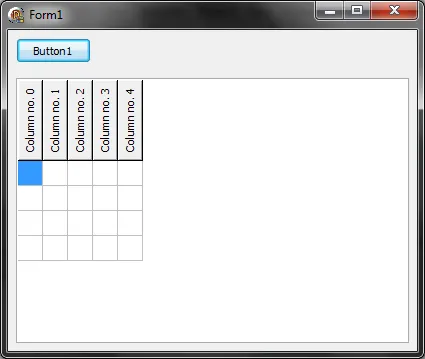我在表单上有一个标准的TStringGrid。 表格中有一行是固定的,包含多列,这些列都是TGridColumns对象。我已经使用对象检查器设置了列标题,并且默认方向是水平的。你可以像Excel单元格中一样使方向垂直吗?
1个回答
7
以下是如何在Lazarus中将第一行文本垂直渲染的方法:
unit Unit1;
{$mode objfpc}{$H+}
interface
uses
Classes, SysUtils, FileUtil, Forms, Controls, Graphics, Dialogs, Grids,
StdCtrls;
type
TStringGrid = class(Grids.TStringGrid)
protected
procedure DrawCellText(ACol, ARow: Integer; ARect: TRect;
AState: TGridDrawState; AText: String); override;
end;
type
TForm1 = class(TForm)
Button1: TButton;
StringGrid1: TStringGrid;
procedure Button1Click(Sender: TObject);
private
{ private declarations }
public
{ public declarations }
end;
var
Form1: TForm1;
implementation
{$R *.lfm}
procedure TStringGrid.DrawCellText(ACol, ARow: Integer; ARect: TRect;
AState: TGridDrawState; AText: String);
var
TextPosition: TPoint;
begin
if ARow = 0 then
begin
Canvas.Font.Orientation := 900;
TextPosition.X := ARect.Left +
((ARect.Right - ARect.Left - Canvas.TextHeight(AText)) div 2);
TextPosition.Y := ARect.Bottom -
((ARect.Bottom - ARect.Top - Canvas.TextWidth(AText)) div 2);
Canvas.TextOut(TextPosition.X, TextPosition.Y, AText);
end
else
inherited DrawCellText(ACol, ARow, ARect, AState, AText);
end;
procedure TForm1.Button1Click(Sender: TObject);
var
I: Integer;
GridColumn: TGridColumn;
begin
for I := 0 to 4 do
begin
GridColumn := StringGrid1.Columns.Add;
GridColumn.Width := 24;
GridColumn.Title.Font.Orientation := 900;
GridColumn.Title.Layout := tlBottom;
GridColumn.Title.Caption := 'Column no. ' + IntToStr(I);
end;
StringGrid1.RowHeights[0] := 80;
end;
end.
以下是如何在Delphi中垂直渲染
TStringGrid第一行文本的方法:我建议使用重写的
DrawCell过程,因为这似乎是最简单的方法。如果您想要在OnDrawCell事件中仅呈现文本,则应考虑以下事项:- 如果将
DefaultDrawing设置为True,则当触发OnDrawCell事件时,文本已经被呈现,因此我建议将单元格标题存储在单独的变量中,而不是Cells属性中,这样就不会呈现任何文本,您可以垂直绘制自己存储的标题。
- 如果将DefaultDrawing设置为False,则必须自己绘制整个单元格,包括3D边框,这并不是很酷,我个人更喜欢让控件为我们绘制背景。以下是使用重写的
DrawCell过程的Delphi代码。文本居中显示在单元格矩形内;请注意,我没有使用DrawTextEx进行文本大小测量,因为此函数不考虑更改后的字体方向。unit Unit1;
interface
uses
Windows, Messages, SysUtils, Variants, Classes, Graphics, Controls, Forms,
Dialogs, StdCtrls, Grids;
type
TStringGrid = class(Grids.TStringGrid)
protected
procedure DrawCell(ACol, ARow: Longint; ARect: TRect;
AState: TGridDrawState); override;
end;
type
TForm1 = class(TForm)
Button1: TButton;
StringGrid1: TStringGrid;
procedure Button1Click(Sender: TObject);
private
{ Private declarations }
public
{ Public declarations }
end;
var
Form1: TForm1;
implementation
{$R *.dfm}
procedure TStringGrid.DrawCell(ACol, ARow: Longint; ARect: TRect;
AState: TGridDrawState);
var
LogFont: TLogFont;
TextPosition: TPoint;
NewFontHandle: HFONT;
OldFontHandle: HFONT;
begin
if ARow = 0 then
begin
GetObject(Canvas.Font.Handle, SizeOf(LogFont), @LogFont);
LogFont.lfEscapement := 900;
LogFont.lfOrientation := LogFont.lfEscapement;
NewFontHandle := CreateFontIndirect(LogFont);
OldFontHandle := SelectObject(Canvas.Handle, NewFontHandle);
TextPosition.X := ARect.Left +
((ARect.Right - ARect.Left - Canvas.TextHeight(Cells[ACol, ARow])) div 2);
TextPosition.Y := ARect.Bottom -
((ARect.Bottom - ARect.Top - Canvas.TextWidth(Cells[ACol, ARow])) div 2);
Canvas.TextRect(ARect, TextPosition.X, TextPosition.Y, Cells[ACol, ARow]);
NewFontHandle := SelectObject(Canvas.Handle, OldFontHandle);
DeleteObject(NewFontHandle);
end
else
inherited DrawCell(ACol, ARow, ARect, AState);
end;
procedure TForm1.Button1Click(Sender: TObject);
var
I: Integer;
begin
for I := 0 to StringGrid1.ColCount - 1 do
begin
StringGrid1.ColWidths[I] := 24;
StringGrid1.Cells[I, 0] := 'Column no. ' + IntToStr(I);
end;
StringGrid1.RowHeights[0] := 80;
end;
end.
以下是内容的翻译:
这就是它的样子:

- TLama
网页内容由stack overflow 提供, 点击上面的可以查看英文原文,
原文链接
原文链接
- 相关问题
- 3 如何在FireMonkey TStringgrid中取消选择单元格
- 3 如何更改与TStringGrid单元格关联的提示文本的字体大小
- 3 如何在TStringGrid中切换单元格的颜色和文本的开关
- 14 Delphi: 如何在字符串网格中更改单元格的颜色
- 3 如何在TStringGrid中显示行号?
- 10 Delphi TStringGrid 闪烁问题
- 15 Delphi XE2中的FillRect无法完全绘制TStringGrid单元格
- 5 如何将 Delphi 7 中的 TStringGrid 转换为 Delphi XE?
- 7 更改TStringGrid单元格字体颜色
- 3 Delphi中的TStringGrid多选,确定已选择的行
这个吗?无论如何,你使用的Delphi版本是什么?我用的是D2009,但里面没有TGridColumns类。 - TLama